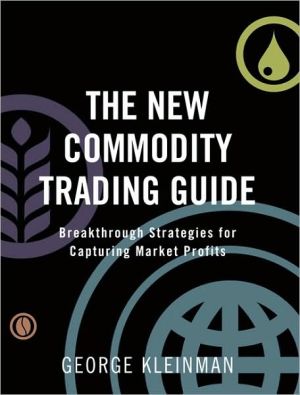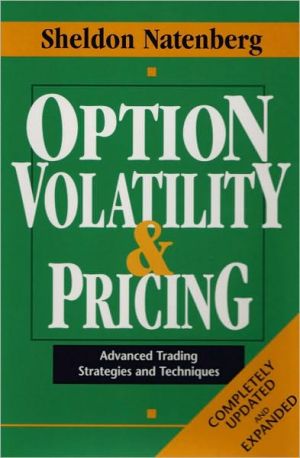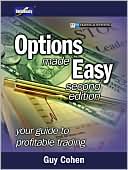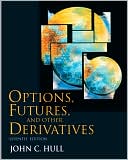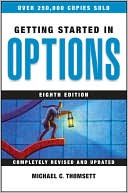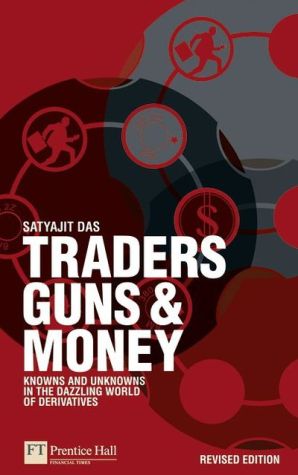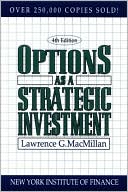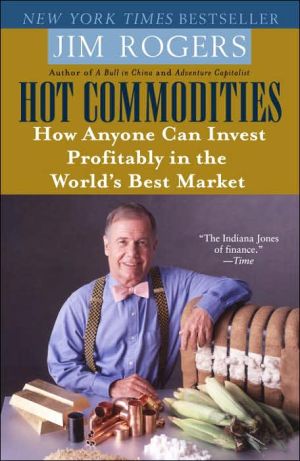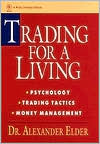The New Commodity Trading Guide: Breakthrough Strategies for Capturing Market Profits
“I’ve been trading stocks and commodities for more than 30 years, and I’ve read any number of how-to books, but George Kleinman’s The New Commodity Trading Guide is as clear, precise, and useful as any book I’ve come across during my career. I cannot recommend it strongly enough, if for no other reason than George finally explains ‘The Voice from the Tomb’ better than any of the old guard at the CBOT. Read it and reap.”—Dennis Gartman, editor/publisher The Gartman Letter, L.C.\ “Commodities...
Search in google:
“I’ve been trading stocks and commodities for more than 30 years, and I’ve read any number of how-to books, but George Kleinman’s The New Commodity Trading Guide is as clear, precise, and useful as any book I’ve come across during my career. I cannot recommend it strongly enough, if for no other reason than George finally explains ‘The Voice from the Tomb’ better than any of the old guard at the CBOT. Read it and reap.”--Dennis Gartman, editor/publisher The Gartman Letter, L.C. “Commodities present great financial opportunity and, as every hedge fund and trader has experienced, great risk. This book shows how to use commodity trading and volatility to capture excess profits while limiting losses. These lessons are as critical for investors as they are for traders, as we are likely to be in a volatile trading environment for the foreseeable future.”--Daniel J. Dart, private investor and COO, Merrill Lynch Investment Managers, Third Party Group (retired) “George Kleinman’s book has just the right blend of practical trading wisdom, technical charting, and fundamental analysis. It’s full of revealing discussions about seasonal trading patterns and long term trends. But most importantly it presents a balanced view that honestly reveals both the difficulties and advantages of being a private commodities trader. There’s something here for both experienced investors and beginners interested in learning from a seasoned expert.”--Jeff Augen, author of The Volatility Edge in Options Trading and Trading Options at Expiration “Ihighly recommend George Kleinman’s The New Commodity Trading Guide. George’s insights, the result of 25 years of successful trading experience, are explained in a way that a new trader can grasp and, at the same time, an experienced trader can translate into his own trading. Best of all, George presents many of his own creative trading methods including his Natural Number Method, explained for the first time in this book.”--Jeff Quinto, president of Transformative Trading and futures trading coach “Since leaving the trading floor, George is one of the few people I still talk to about the markets, and this book clearly shows why. He is able to take classic time-tested methods of technical analysis and adapt them to the conditions faced by today’s electronic traders.”--Andrew Stanton, 20-year veteran of the NY trading floors Over the long term, commodities prices are expected to rise based on massive increases in global demand. But, as many investors have discovered the hard way, merely knowing this is not enough to make consistent profits. Fundamental changes in the commodities markets have occurred that have implications most investors do not understand. For instance, century-old “open outcry” trading floors have now been replaced with computerized trading. In The New Commodity Trading Guide, commodities expert George Kleinman reveals the new practical realities of worldwide electronic commodities trading and specific strategies for capitalizing on today’s radically different markets. Kleinman shows how to leverage the one indicator that consistently drives commodity prices today...introduces the right ways to trade on news and profit from trends...reveals consistent seasonal price shifts that mean huge profits...shows which conventional strategies still work (and which don’t!). Finally, he introduces the Natural Number Method, a breakthrough approach that any commodities trader can use to supercharge performance! Capturing the 5000% returnWhat you can learn from one of history’s fastest price moves “Breaking par”: how you can profit from market psychologyHow to make profitable trades right after market barriers are shattered The trend’s your friend--if you know how to use itDiscover the best times to go with the flow Why markets behave differently at significant break points......and how to use that knowledge to make big profits What hasn’t changed--and how you can profit from itTwo classic chart patterns that continue to work!
Going the Way of the DodoGoing the Way of the Dodo\ “Men, it has been well said, think in herds; it will be seen that they go mad in herds, while they only recover their senses slowly, and one by one.”\ —Charles Mackay, 1841, Memoirs of Extraordinary Popular Delusions and the Madness of Crowds\ The dodo, a flightless bird, has been extinct since the 17th century.\ According to Wikipedia, the verb phrase to “go the way of the dodo” means to become obsolete, to fall out of common usage, or to become a thing of the past. The dodo is considered the poster child for an extinct species because its demise was directly attributable to human activity. (They were good to eat and easy to catch.)\ Have you ever wondered whether the last dodo bird was aware of being the very last one?\ On the first trading day of 2008, the price of crude oil easily exceeded $99 per barrel, due to a Nigerian rebel attack on oil-producing facilities. The rumor circulating trading desks globally was that this would be the day—the first day in history that oil prices would trade at that psychological stratospheric barrier of $100 per barrel.\ I was watching the oil market that day and saw it approach $100, but it never quite reached it. The market traded at a new all-time high of approximately $99.80 but then ran out of steam and rolled over. Oil prices continued trading lower just as I received a “Breaking News” e-mail from Marketwatch that read: “Oil trades at $100 for the first time ever.” I turned to my assistant and asked her what she showed as the high crude oil price. “It’s $99.81,” Nancy told me. “Last print, $99.50.” So I looked at the other delivery months, but they were all trading at a discount—not even close to $100. I thought to myself, they just got it wrong this time.\ That night, I was watching the evening news on NBC and the anchor reported: “Oil in New York traded today, for the first time ever, at $100 per barrel.” “How could they all get this so wrong?” I thought. Then it dawned on me. Like most traders, I was watching the electronic oil market where more than 99% of all trades take place. I didn’t think to check the pit market that hardly anyone traded on or looked at anymore. Sure enough, “the pit” had recorded a different high than “the screen”—exactly $100 per barrel. The wire services had picked up on this feat and reported it as headline news around the world. Of course, this raised the question, why would anyone pay more than the market when they could have easily bought at the screen price? The pit trade is fast disappearing because it’s slower than electronic trading. Was this merely an aberration?\ The next day, the full story came out. On January 2, 2008, 747,748 one-thousand-barrel contracts changed hands, with 99% of them trading on the screen and just one of those contracts trading at the price of $100. This lone contract changed hands (as we had already discovered) in the pit. I really wouldn’t call this a “legitimate” trade, even though an exchange spokesman called it just that in a press release the following day. The man behind this record-high price was an anonymous professional pit trader. Did he make a mistake?\ No, he knew exactly what he was doing. This guy was willing to lose $300 for bragging rights. The BBC subsequently termed this a “vanity trade.” He absolutely overpaid for the right to tell his grandkids, “I was the first person in history to buy $100 oil.”\ This “achievement” will no doubt turn out to be one of the last hurrahs of the pit trader. Electronic trading is faster, cheaper, more efficient, and, in certain ways, more honest than having market makers take the other side of a trade. These are the reasons why the pit trader is fast “going the way of the dodo,” and as with that tasty flightless bird, the pit trader’s demise is directly attributable to human activity.\ It’s Different This Time?\ As you read The New Commodity Trading Guide, be aware that “New” will always be in the title whenever you read this. So at what point does this book become similar to the pit trader—obsolete and no longer “new”?\ The book presents commodity trading in a new light because I believe the commodity markets perform differently today than any time before. During most of my career, which spans more than 30 years, futures trading was viewed as a casino. Now many financial planners treat commodities as an asset class, and they allocate a portion of their portfolios to commodities alongside traditional stocks and bonds. Then consider the electronic factor that has dramatically changed the way the markets behave. Add in increased demand from the emerging economies, the hedge funds and the index funds, and you’ve planted the seeds for change. Because the commodity markets act differently now, new techniques are required for trading success. Still, it’s important to remember that these four words—“it’s different this time”—have collectively resulted in more lost money for more traders than any others.\ A few years after the 1929 stock market crash, the great trader and philanthropist Bernard Baruch wrote a foreword to a reprint of Charles Mackay’s classic Extraordinary Popular Delusions and the Madness of Crowds. Originally published in 1841, Mackay’s book chronicled various investment manias from the 1500s through the 1800s. From the tulip craze to the Mississippi and South Sea Bubbles, the basic underlying premise was that manias (economic and otherwise) are a condition of the human species. They will come and go over time but never disappear. My reprinted edition of Popular Delusions was published in October 1932, right in the thick of the Great Depression. In this quote from the foreword, Baruch refers to that most recent mania he termed the “1929 market madness in America”: “I have often thought that if, in the lamentable era of the ‘New Economics,’ culminating in 1929, even in the presence of dizzily spiraling prices, we had all continuously repeated, ‘two and two still make four,’ much of the evil might have been averted.” Those very words could be used today; just substitute the dates.\ The 1929 panic and eventual recovery from the Great Depression that followed were not firsts for America. Crashes and market panics occurred in 1837, 1857, 1861, 1873, 1893, 1901, and one could make a case for 2008 as well. The 1857 panic was preceded by the California gold rush. The 1873 panic was preceded by a speculatively induced bubble in railroad stocks. The panic of 2008 was preceded by a speculative boom in housing prices that created the subprime debacle. Still, more has been written about the 1929 crash than any other crash in history because more people in the newly minted middle and upper classes were affected, and also because few people saw it coming. People held a widespread belief at that time in the “new economics”: A period of permanent prosperity had arrived. Certainly, the 1920s was an unprecedented period of prosperity, with new wealth created from the automobile industry and the accompanying boom in road building and travel. A plethora of new technologies and new household electronic appliances, such as the radio, were born. To top it all off, the 1920s saw the creation and widespread use of installment credit products. Perhaps this was one of the main unsung underlying causes of the crash. Looking at modern history, we can point to the dotcom mania of the late 1990s. In recent years, examples include the condo mania in Florida and Las Vegas and the subprime housing crisis in California and many other places. Obscure manias also pop up nearly every year but fail to reach the mainstream media because they affect only a few of those directly involved. (I chronicle one of these, with the accompanying valuable lessons, in Chapter 2, “Capturing a 5,000% Return,” a recent commodity bubble that ended with the inevitable burst.)\ One shared trait of all manias is that the majority of players never see the collapse coming. If you read the financial press from 1929 to 1931, all during the period the market was falling, respected analysts continually considered it a correction that would soon be over. When stocks finally did hit bottom in 1933, more than 80% of all value had been lost. Will this be how the current commodity boom ends? Will today’s commodity bubble burst? The answer to this question is, yes, it certainly will end badly because the history of mankind is that all economic bubbles eventually burst. The only question is, when? It will take place after any bull market move in a particular commodity market morphs into a mania. This will be the time when the general public is totally immersed in the story of the day. It’s never “different this time”: It always ends the same way—badly for the general public. However, as this is being written, I question the premise that, in a macro sense, this commodity bull run is anything close to a mania or a bubble. It’s more similar to a balloon, inflating and deflating but overall somewhere at the half inflation point. Before the 1929 stock market crash, shares in shell companies were being manufactured without economic justification, and only because people would buy them. In contrast, commodities have intrinsic value and are being consumed by those who buy them.\ So how will we know the final top is in for commodities as an asset class?\ When analyzing any market move for a top, ask yourself whether the market you’re looking at is currently spiraling. Does it look similar to a flagpole growing up to the sky (which the laws of physics tell us cannot last indefinitely), or has it recently been cleansed and purged via a healthy correction? In the middle of a move, some of the air (the buying) that was pumped in flows out before new air is pumped in. One of my goals for this book is to teach you how to recognize the early signs of a new bull run, and also how to recognize the end of the run.\ One type of top is the blow-off top, a formation that occurs at the end a sustained bull market run. How can you tell if a market is in a blow-off top? Close to the end of the move, during the top formation, the market surges higher, with only shallow corrections. Compared to the norm, volumes are huge. Technical indicators such as the RSI (an oscillator) run up to extremely high (overbought) readings, but although these readings appear to be in unsustainable territory, the market continues moving higher than anyone believed possible. Then you’ll hear outlandish price predictions in the mainstream media, and talk of shortages will be rampant. The talk will be that the world is going to run out of this or that. In many cases, the last 48 hours of a major move can be the most feverish—and the most lucrative for the bulls. This final surge that forms the actual blow-off is the most painful for the bears. Their capitulation (short covering) creates the final high prices. Nobody I know of is able to pick the exact top in a situation such as this. However, in markets that show these signs, if you have been fortunate enough to be on for some of the ride, it’s time to be vigilant because the end is near. The top price will come when nobody is looking and generally when the news is as bullish as it can get.\ Most people will see the first break from the top price as a normal correction, just a temporary break within a bull that is nowhere close to being over yet. The market might have a secondary rally after the first break, but then it will be unable to register new highs. Without most of the players realizing it’s happening, the air will be let out of the bubble. Then one day it will whoosh. Bullish news might continue during much of the move back down. At some point, the bull turns into a bear, the decline accelerates, and ultimately there’s blood in the streets. This is the time when the news will turn very bearish, there will be a multiyear surplus of this or that, and it will appear that the bear has settled in for the long pull. In reality, as only the smart money will see during blood in the streets, the bear is losing the game and will soon be replaced by a young bull.\ As this is being written, the macro forces of a continuing global commodity bull trend appear to remain in force. The balloon is inflating, not deflating. Sure, there have been, and will continue to be, plenty of healthy corrections along the way, but consider these merely temporary tops.\ Let’s briefly discuss the fundamentals that lead me to believe this current commodity bull will be running for quite some time yet. We know explosive demand growth exists in the developing world, with no easy way to turn this train around. More than a billion consumers are moving up to a higher level of consumption, demanding the comforts the West has enjoyed since the third Industrial Revolution that began in the early 1900s. For many decades, one billion of Earth’s human inhabitants have consumed two-thirds of Earth’s developed resources. The other six billion got by on the remaining third. Now, led by China and India, the developing world is eating better and living better, and this requires massive commodity consumption. These people are transitioning from being mainly producers to a combination of producers and consumers. From a macro sense, this places upward pressure on commodity prices.\ The magnitude of this unprecedented demand shock is difficult to comprehend, as these people drive more cars and consume more protein and electric power. Heating, lighting, air conditioning, and appliances require power plants. New buildings, roads, ships, ports, trains, trucks, and buses—the list goes on. Energy needs, food requirements, textiles, copper to build new electrical grids, corn and soybean meal to feed growing populations of pigs, chicken, and cattle. Soybeans, cotton, rice, sugar, and corn for food and fuel, with more fertilizer needed to grow these crops.\ The global population is growing at 80 million people annually. This is the equivalent of adding one Mexico to the world every year. The areas of the world with the greatest population percentage increases are moving toward the consumption patterns of the developed world. And while all this is taking place, the developed world continues to consume. And it’s not just India and China that are players in this industrial revolution. Other rapidly emerging Asian nations, Eastern Europeans, Russians, and South Americans (with Brazil in the forefront) are all creating massive new consumer middle classes. But let’s concentrate on China for a few paragraphs.\ As we go to press, the average American is using approximately 25 barrels’ worth of oil annually. To put this number in perspective, at the conclusion of World War II when the Japanese economy was in ruins, the Japanese consumed the equivalent of one barrel per capita annually. Now that Japan has become a modern industrialized power, the average Japanese person consumes approximately 17 barrels of oil annually. A decade ago, the average Chinese person consumed about one barrel annually, and now this number is rapidly approaching two. What happens when this number doubles again and then quadruples? On a daily basis, the world is using all the oil it can produce. For example, we have about 900 cars for every 1,000 people in the United States. By comparison (and this number is constantly growing and will be outdated by the time you read it), only 45 people per 1,000 own cars in China. If vehicle ownership there doubles to 90, how will this affect the demand for aluminum and rubber in auto manufacturing? China recently surpassed the United States as the world’s largest copper consumer. And what about oil? As we know, a large percentage of global oil supplies are produced in volatile places. China is an oil importer, and as its oil consumption grows, what happens every time a disruption occurs due to an outage, pipeline problem, hurricane, war, or some political event in a producing country? Chinese per-capita income has risen from less than $500 in 1990 to $3,000 in 2008, and Indian per-capita income has risen from less than $500 in 1990 to more than $1,000 in 2008. This stimulates energy demand, not to mention demand for more and better food.\ North American farmers have experienced great growing weather for most of the past 100 years. This benefit, combined with improvements in agriculture, has resulted in abundant crops. You have to go back 800 years to find a period of such favorable weather for such a long time. Yet as 2008 has shown, we know what can happen to the price of wheat, for example, if a few crop failures occur around the world—prices can easily triple. Considering how good weather has generally been during the past two decades; food stocks in corn, wheat, soybeans, and rice seem to remain dangerously low year after year. With another Mexico being added to the world’s population each year, the demand side of the equation will not solve this problem. With global warming an impending dilemma for crops, can the world continue to rely on the supply side growing? When the world again experiences a year of bad weather (whether too much rain or too little, temperatures too hot or too cold), food prices are set to surge again.\ Fundamentals are important because they set the tone for commodity price moves. However, increasingly in this new electronic age, fundamental analyses will not help you in your trading. The fundamentals for many of the markets we trade are complex and often conflicting. I’ve designed this book to help the individual trader. With that in mind, realize that it’s virtually impossible for an individual to sort through the thousands of statistics that comprise the European economy to accurately determine the direction the Euro will be moving today. Many traders have wondered why something like this happens: On the day it was announced that the supplies of crude oil went down an extremely bullish five million barrels in the weekly report (and the traders were looking for an increase), how could the market close lower? Apparently, some hidden evil fundamental must have been lurking (“evil” because we were long that day) that caused that crash. As with the European currency, the fundamentals for oil (and all the other commodities, for that matter) are complex. During any particular trading session, assembling all the supply and demand data bits into a trading strategy is impossible. However, you can analyze one dominant fundamental to achieve profitability.\ George Soros wrote, “The most important fundamental is credit flow”—or to put this more simply, money. Money flows move markets, and this is the most important determinant of price action. My premise is that you need to correctly analyze only this one fundamental to be successful: which direction the money is flowing. How do we do this? This book addresses that very question. As we go to press, the time is still ripe to capitalize on the continuing macro bull trend in commodities. However, when it does finally come to an end, the book won’t be obsolete. My plan is to also help you capitalize on the bear trend, and I explore techniques and methodologies—for both scenarios.\ Our topic is as old as the hills. Commodities are necessary for life and comfort, and will continue to be traded as long as the human race exists. Every economy has experienced long periods of negative growth when commodity prices were depressed (as some are today). Then the bull cycles occur. Today the current global bull commodity cycle is about a decade old. Mini cycles, such as the commodity decade of the 1970s, lasted about ten years. However, long-term charts beginning in the 1700s tell us that major bull cycles in commodities generally range from 18 to 23 years. For example, as humankind entered the twentieth century, the last (the third great) Industrial Revolution lasted nearly 30 years. How long will this one last? I am a good enough student of mass psychology to know that this book will remain popular only as long as commodities are in a bull cycle. The public is not interested in bear cycles. So perhaps one way to determine whether the globe is still experiencing a bull commodity cycle is to ask where you bought (and I do hope you bought) The New Commodity Trading Guide? Did you buy it new at full price, or used at a discount? The latter might be an indication that this cycle has run its course.\ In my current time frame, as this is being written, America, and by contagion much of the globe, is going through a colossal financial crisis. The major investments banks of Bear Stearns and Lehman Brothers, both in business for more than 100 years, are now both gone. The U.S. government has bailed out Freddie Mac and Fannie Mae and taken over AIG, and there will be additional bailouts and more money printing ahead of us. It’s a real financial mess, with countless paper assets plummeting in value. Although liquidity problems can bleed over into commodity values at times, unlike the stock or bond of a failed financial entity, commodity prices will always rebound because they are necessary to sustain and enhance life.\ I anticipate that commodities will continue to be hot for years to come because the world has entered a period of tightening commodity supplies with increasing demand. The planet’s resources are limited, and commodities can play a role in your asset-allocation decisions. However, if the cycle has run its course, realize that bear cycles can be as profitable as their counterpart, and they can move much faster. Just follow the money flows.\ Perhaps as you read this, oil use will have been replaced by some alternative energy source, but the macro trend of accelerating commodity consumption will likely continue unabated. More important, the trend of accelerating power usage will continue, and the new challenge will be avoiding power shortages. No quick solution exists for electricity shortages, and I anticipate that this will become a growing problem as global power demand accelerates. Many of the best trading opportunities lie ahead of us, but be aware of ebb and flow to all of this. There’s a time for all things, and one day the bull will lose control and then the bear will take over. As you read this, I have no way of knowing whether the bull or the bear is winning the race you choose to join this week.\ Baruch began his 1932 foreword to Popular Delusions by telling us that “all economic movements, by their very nature, are motivated by crowd psychology.” This is a truism, but it’s magnified today because the crowd has grown much bigger than at any time in the history of the human species. When Baruch wrote his foreword, it was during the depths of the Great Depression. This must have been a time of deep and total despair for many, yet humankind always seems to muddle through the bad times, as he so sagely concluded we would at that time: “Similarly, even in this general moment of gloom in which this foreword is written, when many begin to wonder if declines will never halt, the appropriate abracadabra may be: ‘They always did.’”\ George Kleinman Lake Tahoe, Nevada September 2008\ Praise for The New Commodity Trading Guide\ “I’ve been trading stocks and commodities for more than 30 years, and I’ve read any number of how-to books, but George Kleinman’s The New Commodity Trading Guide is as clear, precise, and useful as any book I’ve come across during my career. I cannot recommend it strongly enough, if for no other reason than George finally explains ‘The Voice from the Tomb’ better than any of the old guard at the CBOT. Read it and reap.”\ —Dennis Gartman, editor/publisher The Gartman Letter, L.C.\ “Commodities present great financial opportunity and, as every hedge fund and trader has experienced, great risk. This book shows how to use commodity trading and volatility to capture excess profits while limiting losses. These lessons are as critical for investors as they are for traders, as we are likely to be in a volatile trading environment for the foreseeable future.”\ —Daniel J. Dart, private investor and COO, Merrill Lynch Investment Managers, Third Party Group (retired)\ “George Kleinman’s book has just the right blend of practical trading wisdom, technical charting, and fundamental analysis. It’s full of revealing discussions about seasonal trading patterns and long term trends. But most importantly it presents a balanced view that honestly reveals both the difficulties and advantages of being a private commodities trader. There’s something here for both experienced investors and beginners interested in learning from a seasoned expert.”\ —Jeff Augen, author of The Volatility Edge in Options Trading and Trading Options at Expiration\ “I highly recommend George Kleinman’s The New Commodity Trading Guide. George’s insights, the result of 25 years of successful trading experience, are explained in a way that a new trader can grasp and, at the same time, an experienced trader can translate into his own trading. Best of all, George presents many of his own creative trading methods including his Natural Number Method, explained for the first time in this book.”\ —Jeff Quinto, president of Transformative Trading and futures trading coach\ “Since leaving the trading floor, George is one of the few people I still talk to about the markets, and this book clearly shows why. He is able to take classic time-tested methods of technical analysis and adapt them to the conditions faced by today’s electronic traders.”\ —Andrew Stanton, 20-year veteran of the NY trading floor\ © Copyright Pearson Education. All rights reserved.
Introduction Going the Way of the Dodo 1Chapter 1 Eliminating People 11Chapter 2 Capturing a 5,000% Return 21Chapter 3 Two Chart Patterns That Work 29Chapter 4 The Voice from the Tomb (Super Seasonal #1) 47Chapter 5 The Soy Secret (Super Seasonal #2) 53Chapter 6 The Significant News Indicator 59Chapter 7 Breaking Par 71Chapter 8 The Trend Is Your Friend 79Chapter 9 The Natural Number Method 85Chapter 10 Trading Chaos 153Appendix A Moving Average Primer, an Open Interest Primer, and the Advanced Open Interest Course 157
